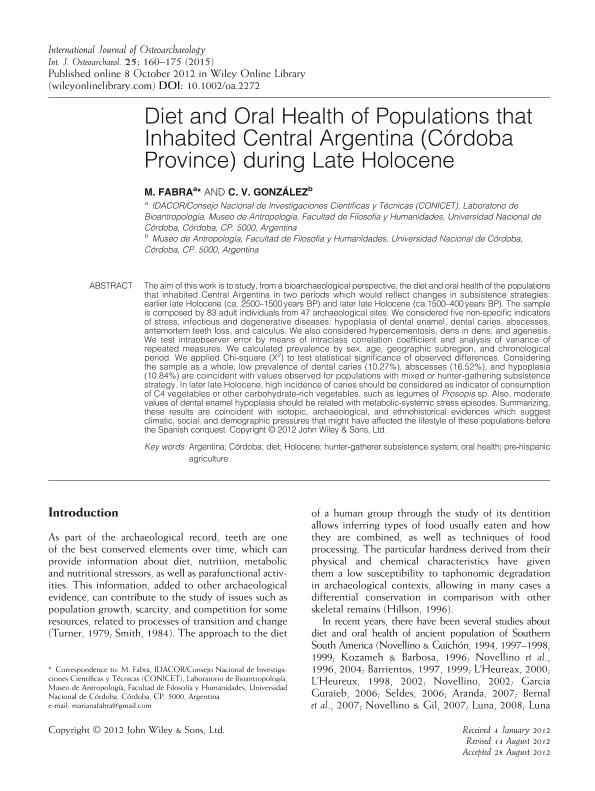Mostrar el registro sencillo del ítem
dc.contributor.author
Fabra, Mariana

dc.contributor.author
Gonzalez, Claudina

dc.date.available
2018-07-05T18:51:58Z
dc.date.issued
2015-03
dc.identifier.citation
Fabra, Mariana; Gonzalez, Claudina; Diet and oral health of populations that inhabited central Argentina (Córdoba Province) during late holocene; John Wiley & Sons Ltd; International Journal of Osteoarchaeology; 25; 2; 3-2015; 160-175
dc.identifier.issn
1099-1212
dc.identifier.uri
http://hdl.handle.net/11336/51396
dc.description.abstract
The aim of this work is to study, from a bioarchaeological perspective, the diet and oral health of the populations that inhabited Central Argentina in two periods which would reflect changes in subsistence strategies: earlier late Holocene (ca. 2500-1500years BP) and later late Holocene (ca.1500-400years BP). The sample is composed by 83 adult individuals from 47 archaeological sites. We considered five non-specific indicators of stress, infectious and degenerative diseases: hypoplasia of dental enamel, dental caries, abscesses, antemortem teeth loss, and calculus. We also considered hypercementosis, dens in dens, and agenesis. We test intraobserver error by means of intraclass correlation coefficient and analysis of variance of repeated measures. We calculated prevalence by sex, age, geographic subregion, and chronological period. We applied Chi-square (X2) to test statistical significance of observed differences. Considering the sample as a whole, low prevalence of dental caries (10.27%), abscesses (16.52%), and hypoplasia (10.84%) are coincident with values observed for populations with mixed or hunter-gathering subsistence strategy. In later late Holocene, high incidence of caries should be considered as indicator of consumption of C4 vegetables or other carbohydrate-rich vegetables, such as legumes of Prosopis sp. Also, moderate values of dental enamel hypoplasia should be related with metabolic-systemic stress episodes. Summarizing, these results are coincident with isotopic, archaeological, and ethnohistorical evidences which suggest climatic, social, and demographic pressures that might have affected the lifestyle of these populations before the Spanish conquest.
dc.format
application/pdf
dc.language.iso
eng
dc.publisher
John Wiley & Sons Ltd

dc.rights
info:eu-repo/semantics/openAccess
dc.rights.uri
https://creativecommons.org/licenses/by-nc-sa/2.5/ar/
dc.subject
Argentina
dc.subject
CÓRdoba
dc.subject
Diet
dc.subject
Holocene
dc.subject
Hunter-Gatherer Subsistence System
dc.subject
Oral Health
dc.subject
Pre-Hispanic Agriculture
dc.subject.classification
Historia

dc.subject.classification
Historia y Arqueología

dc.subject.classification
HUMANIDADES

dc.title
Diet and oral health of populations that inhabited central Argentina (Córdoba Province) during late holocene
dc.type
info:eu-repo/semantics/article
dc.type
info:ar-repo/semantics/artículo
dc.type
info:eu-repo/semantics/publishedVersion
dc.date.updated
2018-07-04T19:25:02Z
dc.journal.volume
25
dc.journal.number
2
dc.journal.pagination
160-175
dc.journal.pais
Reino Unido

dc.journal.ciudad
Londres
dc.description.fil
Fil: Fabra, Mariana. Consejo Nacional de Investigaciones Científicas y Técnicas. Centro Científico Tecnológico Conicet - Córdoba. Instituto de Antropología de Córdoba. Universidad Nacional de Córdoba. Facultad de Filosofía y Humanidades. Instituto de Antropología de Córdoba; Argentina
dc.description.fil
Fil: Gonzalez, Claudina. Consejo Nacional de Investigaciones Científicas y Técnicas; Argentina. Universidad Nacional de Córdoba. Facultad de Filosofía y Humanidades. Museo de Antropología; Argentina
dc.journal.title
International Journal of Osteoarchaeology
dc.relation.alternativeid
info:eu-repo/semantics/altIdentifier/doi/https://dx.doi.org/10.1002/oa.2272
dc.relation.alternativeid
info:eu-repo/semantics/altIdentifier/url/https://onlinelibrary.wiley.com/doi/abs/10.1002/oa.2272
Archivos asociados
